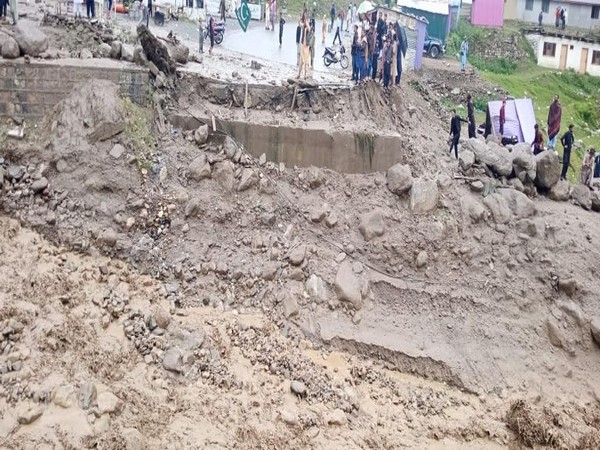
Islamabad [Pakistan], August 27 (ANI): A United Nations relief agency in its report said that at least 2,18,000 houses were completely destroyed and 458 thousand houses were damaged in the past two weeks in Pakistan floods. The UN Office for the Coordination of Humanitarian Affairs (OCHA) said that 218 thousand houses were completely destroyed, 458 thousand houses damaged, 2 million acres of crops impacted, 794 thousand livestock lost, 937 deaths and 1343 injured in the past two weeks.
116 districts were affected after “rainfall nationwide is 2.87 times higher than the national 30-year average, with some provinces receiving more than five times as much rainfall as their 30-year average. The humanitarian situation is expected to worsen.
Over 218,000 houses have been destroyed and a further 452,000 damaged since 14 June, according to the NDMA. Livelihoods are also being heavily impacted – more than 793,900 livestock – a critical source of sustenance and livelihoods for many families – have died, of which some 63 per cent are in Balochistan and 25 per cent in Punjab.
Around 2 million acres of crops and orchards have also been impacted, including at least 304,000 acres in Balochistan, 178,000 acres in Punjab and some 1.54 million acres in Sindh, said the report.
Damage to infrastructure has further worsened the humanitarian situation, as the partial or complete destruction of over 3,000 km of roads and 145 bridges impedes the ability of people to flee to safer areas or to travel to access markets, healthcare, or other vital services, and restricts the delivery of aid to people in need.
Internet outages have also been reported, with the Pakistan Telecommunications Authority attributing widespread internet cuts in central and northern Pakistan on 19 August to technical faults in the fibreoptic network resulting from the heavy rains and floods, added the report.
Provisional data from provincial Education Departments show that at least 17,566 schools have been damaged or destroyed due to the emergency: 15,842 schools in Sindh, 544 in Balochistan and 1,180 in Punjab.
Additionally, at least 5,492 schools are reportedly being used to accommodate displaced people, said the report Near incessant rainfall is compounding flash flooding and rain-induced landslides by rapidly filling up dam reservoirs, posing further risk to people in the vicinity and downstream. The humanitarian situation in Pakistan has deteriorated further over the past two weeks as heavy rains continue to cause flooding, and landslides resulting in displacement and damage across the country.
Sixty-six districts have been officially declared to be ‘calamity hit’ by the Government of Pakistan – 31 in Balochistan, 23 in Sindh, nine in Khyber Pakhtunkhwa (KP) and three in Punjab. The situation remains dynamic, and many more districts have been affected; the number of calamity-declared districts is expected to rise as rains continue to fall.
Pakistan floods death toll crosses 1,000, rainfall continues

Islamabad [Pakistan], August 28 (ANI): The death toll from floods has crossed 1,000 in Pakistan and thousands more have been injured or displaced since June. At least 1,033 people have died while 1,527 have been injured since June 14 from the rains and floods, Geo News reported citing National Disaster Management Authority (NDMA). In the last 24 hours, close to 119 people died and 71 were injured.
As per the data, four died in Balochistan, six in Gilgit Baltistan, 31 in Khyber Pakhtunkhwa, and 76 in Sindh.
Cumulative data from June 14 from across Pakistan showed that 3,451.5 km of road has been damaged, and 149 bridges have collapsed, 170 shops were destroyed. A total of 949,858 homes have been partially or fully destroyed. Out of the total, 662,446 homes have been partially damaged, and 287,412 have been fully destroyed. While 719,558 livestock has also been killed.
At least 110 districts of Pakistan have been hit by the floods with 72 of those districts declaring calamity hit, according to Geo News. Pakistan is grappling with its worst natural disaster in over a decade. The floods affected the lives of millions of people after which the Pakistan government declared a “national emergency”.
The NDMA’s latest sitrep shows that 5,773,063 people have been affected by the floods. However, it clarified that the data in today’s sitrep was based on confirmed figures but its estimates showed that more than 33 million of the population has been affected by the floods.
The authority shared that 51,275 have been rescued while 498,442 have been moved to relief camps.
The NDMA shared that Pakistan’s 30-year average showed that the country has received 134mm of rain and this year it received 388.7mm of rain. 190.07% more than the average.
As of 25 August, Pakistan has experienced 375.4 mm of rainfall – 2.87 times higher than the national 30-year average of 130.8 mm. These rains have primarily fallen on Balochistan, Sindh and parts of Punjab, with Balochistan receiving five times its average 30-year rainfall and Sindh receiving 5.7 times its 30-year average, the statement reads. On 26 August, the Pakistan Meteorological Department (PMD) Flood Forecasting Division (FFD) issued a warning that very high to exceptionally high-level flooding is expected in River Kabul at Nowshera in KP province, as well as in tributaries of the Kabul and Indus rivers until 28 August.






